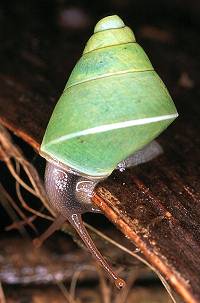Tropical Land Snail Diversity
Fred Naggs and Dinarzarde Raheem, Department of Zoology
Why tropical snails?

Very few snails possess green shells. More often, as with this endemic Sri Lankan snail Beddomea albizonatus, the shell is semi transparent, allowing the green coloured body to show through.
There are more recorded extinctions of land snails than for all other animal groups combined. This makes land snails a key group for recognising why and where extinctions are taking place and also means that snails might act as the sensitive indicators of environmental change that are needed to demonstrate that conservation measures are effective. The speed with which the current episode of extinctions happened and continue to take place means that natural processes are negligible and losses in biological diversity are due to human impact on the environment.
Snail diversity, often associated with high levels of snail endemism, is concentrated in tropical rainforest. Fragmentation, loss and transformation of tropical forests and the introduction of alien species have caused most of the current wave of snail extinctions and many snail faunas are threatened. Some 'weed species' of snails are serious agricultural pests and some snails are vectors of human pathogens. In addition to being of considerable value as sensitive indicators of habitat quality and indicators of centres of biotic diversity and endemism, by any measure, land snails are a high priority for conservation in their own right.
The problem is that there are few snail taxonomists and snails are rarely included in biodiversity and conservation programmes. Our aim is to facilitate and promote the study of land snails as key elements of the biota for both understanding and conserving biological diversity, especially in biologically rich areas of the world where diversity is under greatest threat.

The Darwin Initiative
The Darwin Initiative was launched at the 1992 United Nations Conference on Environment and Development (the 'Rio Earth Summit') as part of the British government's response to the resulting Convention on Biological Diversity. Run by the Department for Environment Food and Rural Affairs (DEFRA), The Darwin Initiative seeks to help safeguard the world's biodiversity by drawing on British biodiversity strengths to assist countries that are rich in biodiversity but poor in financial resources.
We gratefully acknowledge the Darwin Initiative for funding our 1999-2002 project Land Snail Diversity in Sri Lanka (grant no. 162/08/214), for 2003-2005 post-project funding of Land Snails as Models for Biodiversity Assessment in Sri Lanka (grant no. E1 DPO 1) and our 2006 - 2009 current project Developing land snail expertise in South and Southeast Asia (Grant no. 15018).
Acknowledgements
Professor Michael Akam FRS and Dr Richard Preece, the University Museum of Zoology Cambridge, have provided invaluable support and access to their collections, in addition we are grateful for a John Stanley Gardiner Award from the Department of Zoology, University of Cambridge that allowed Dinarzarde Raheem to complete her PhD. We are grateful for the 2004 -2006 award from the Leverhulme Trust for A molecular phylogeny of the stylommatophoran land snails. This joint project with Dr Christopher Wade and Dr Cendrine Hudelot at Nottingham University provided powerful evidence for the faunal history of land snails relevant to future conservation. For funding translation and publication in Sinhala and Tamil of our Sri Lankan land snail field guides we are grateful to the 2003 World Bank and Dutch Government Forestry and Biodiversity Program. We have received continued support in many ways from The Malacological Society of London. The Percy Sladen Trust provided additional support.
We are indebted to our colleagues at the Natural History Museum and to past and current overseas project partners:
- Chulalongkorn University, Thailand.
- Ashoka Trust for Research in Ecology and the Environment, India.
- The Wildlife Heritage Trust, Sri Lanka.
- Centre for Biological Conservation, Nepal.
- University of Antwerp, Belgium.
- Hanoi University, Vietnam.
- National University of Laos.
- University Sain Malaysia
- The Department of National Museums, Sri Lanka.
- The University of Peradeniya, Sri Lanka.
- The Ministry of Environment & Natural Resources, Sri Lanka.